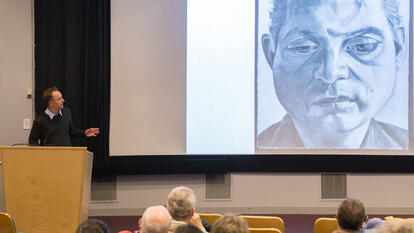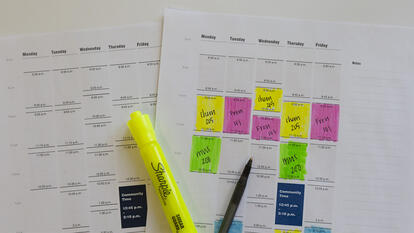Neuroscience Professor Sara Wasserman ’02 on the Brain, Behavior, and Wellesley

“From the moment we wake up in the morning until the moment we fall asleep, we are constantly barraged with sensory stimuli: the smell of coffee, the buzzing of the alarm, the dinging of email alerts,” says Sara Wasserman, Kresa Family Assistant Professor of Neuroscience at Wellesley. “Yet somehow, we prioritize what’s relevant, and ignore the rest in order to respond appropriately each moment.”
What we respond to, and how, depends on a range of factors, including our internal physiological states and external environments, she says. Something as simple as how we respond to the smell of coffee relies on a complex and constant integration of our biology and our environment. In some cases, missteps in integration can lead to maladaptive behaviors or disorders, such as ADHD and schizophrenia. Yet little is known about how the brain supports sensory integration.
Wasserman and her research team are attempting to uncover this mystery. By comparing fruit flies native to forested areas (Drosophila melanogaster) with those from the Mojave Desert (Drosophila mojavensis), they were the first to discover that these two species assign different values (attractive or aversive) to the same moving visual stimulus. Their preliminary findings also suggest that changes in physiology can influence behavioral responses to visual stimuli.
By studying how fruit flies assimilate sensory cues, Wasserman aims to illuminate how a healthy brain produces behaviors that support survival in ever-changing environments.
Q: What inspired you to become a neuroscientist?
Sara Wasserman: As an undergraduate, I majored in neuroscience and theater studies. I am grateful to Professor Barbara Beltz for giving me the opportunity to develop my first independent research project and the space to explore my interests.
After Wellesley, I taught for two years at the John Thomas Dye School (K-6) in Los Angeles. This is where I discovered my passion for teaching and decided to pursue a PhD. I wanted to know why, when I presented all the same stimuli to a group of students, there could be a wide variety of responses. What was happening in the brain that led to this variability? How did students know how to respond appropriately in many different environments?
Q: What led you to your current line of research?
Wasserman: In graduate school, I examined how the brain controls behavior using the model organism C. elegans (microscopic soil nematodes) under the guidance of Piali Sengupta at Brandeis University. Worms and flies are incredibly valuable in brain-behavior studies. These animals have magnitudes fewer neurons than we do, yet they can produce an array of complex behaviors that adapt to changing internal and external conditions.
More recently, in Mark Frye’s lab at UCLA, I learned to code. It’s where I made the switch from worms to flies, and maintained access to a huge array of tools to explore how genes and neural circuits generate behavior.
Q: What’s next?
Wasserman: Currently, my lab is examining how external environment and internal physiological states impact how fruit flies respond to sensory stimuli. We all have strong odor preferences that are linked to our environment. For example, you may smell oatmeal cookies as you walk by a bakery, remember the pleasant smell coming from your grandmother’s kitchen, and stop inside to pick up a cookie. Fruit flies develop these same odor preferences based upon the food sources in their environment. It is known that geographically isolated populations of fruit flies have odor preferences that correspond to local features of their environment. However, few studies have investigated whether certain environments could also drive changes in visual preferences. In other words, like smell, could the features that we see in our environment influence how we respond to visual cues? Recent work from my lab reveals that they can.
We utilize a multifaceted approach including genetic and optogenetic manipulation, virtual-reality flight simulators, and, in collaboration with colleagues at UCLA, in-vivo two-photon calcium imaging. Using these cutting-edge techniques, we intend to further characterize differences in responses to visual stimuli and identify any anatomical differences in eye structure between species in diverse environments.
Q: You draw upon multiple disciplines in your work. What other fields influence your thinking about neuroscience?
Wasserman: One of the things that became apparent during my PhD work was that learning to code and being open to learning how to build things meant that I wouldn’t be limited in the types of questions I wanted to ask based on the materials available. Rather, if I understood the language of coding and building, then I could construct new rigs myself or, if I needed more expertise, I knew what kinds of things were possible.
Many domains influence my thinking about neuroscience. Wondering why I chose to purchase a particular item in the grocery store, seeing two squirrels chasing after each other, reading a novel, listening to music, or watching a play—all of these things might get me to think about a question in the lab differently, or inspire the next direction in my research.
I tell my students that I think of neuroscience as the liberal arts of the sciences! There is still so much to learn about how the brain works, and we need people interested in asking questions through a variety of lenses to crack the tough questions.
Q: How has Wellesley shaped your career?
Wasserman: Wellesley has been instrumental in my career, and perhaps even more so in shaping the kind of person I want to be in the world. The Wellesley motto really resonated with me when I was applying to colleges. The idea of serving was something I could do every day. It didn’t have to be through huge transformative acts (although those are great too!) but rather, how I interacted with people during the small moments. I saw this modeled by professor after professor. Math professor Megan Kerr sat with me at every office hour until calculus “clicked.” Professor Nora Hussey in the theater department cultivated my love for comedic performance and demonstrated the discipline and hard work that goes into honing one’s craft. Professor Barbara Beltz supported my love of science by taking me into her research lab and giving me the opportunity to develop my own project. All of these professors, and more, modeled patience and gave me a space to know that it was okay for me to fail, and that, in fact, it is impossible to grow without doing so. From office hours to the stage to the lab, Wellesley supported my curiosity and gave me the scaffolding to feel confident to pursue a PhD in the sciences. The friendships and community I built, and have been lucky enough to come back to, are what allow me to push forward in my research and career.
Photo: Wasserman (left) works with Crystal Zhu ’19 on her senior thesis in May 2019.



